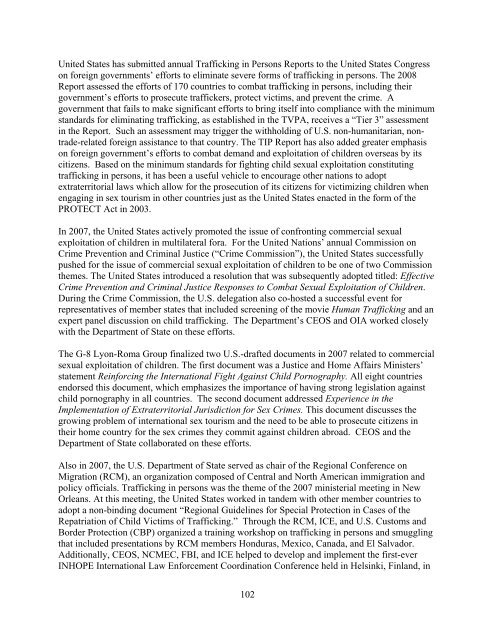The National Strategy for Child Exploitation Prevention and Interdiction
The National Strategy for Child Exploitation Prevention and Interdiction
The National Strategy for Child Exploitation Prevention and Interdiction
You also want an ePaper? Increase the reach of your titles
YUMPU automatically turns print PDFs into web optimized ePapers that Google loves.
United States has submitted annual Trafficking in Persons Reports to the United States Congresson <strong>for</strong>eign governments’ ef<strong>for</strong>ts to eliminate severe <strong>for</strong>ms of trafficking in persons. <strong>The</strong> 2008Report assessed the ef<strong>for</strong>ts of 170 countries to combat trafficking in persons, including theirgovernment’s ef<strong>for</strong>ts to prosecute traffickers, protect victims, <strong>and</strong> prevent the crime. Agovernment that fails to make significant ef<strong>for</strong>ts to bring itself into compliance with the minimumst<strong>and</strong>ards <strong>for</strong> eliminating trafficking, as established in the TVPA, receives a “Tier 3” assessmentin the Report. Such an assessment may trigger the withholding of U.S. non-humanitarian, nontrade-related<strong>for</strong>eign assistance to that country. <strong>The</strong> TIP Report has also added greater emphasison <strong>for</strong>eign government’s ef<strong>for</strong>ts to combat dem<strong>and</strong> <strong>and</strong> exploitation of children overseas by itscitizens. Based on the minimum st<strong>and</strong>ards <strong>for</strong> fighting child sexual exploitation constitutingtrafficking in persons, it has been a useful vehicle to encourage other nations to adoptextraterritorial laws which allow <strong>for</strong> the prosecution of its citizens <strong>for</strong> victimizing children whenengaging in sex tourism in other countries just as the United States enacted in the <strong>for</strong>m of thePROTECT Act in 2003.In 2007, the United States actively promoted the issue of confronting commercial sexualexploitation of children in multilateral <strong>for</strong>a. For the United Nations’ annual Commission onCrime <strong>Prevention</strong> <strong>and</strong> Criminal Justice (“Crime Commission”), the United States successfullypushed <strong>for</strong> the issue of commercial sexual exploitation of children to be one of two Commissionthemes. <strong>The</strong> United States introduced a resolution that was subsequently adopted titled: EffectiveCrime <strong>Prevention</strong> <strong>and</strong> Criminal Justice Responses to Combat Sexual <strong>Exploitation</strong> of <strong>Child</strong>ren.During the Crime Commission, the U.S. delegation also co-hosted a successful event <strong>for</strong>representatives of member states that included screening of the movie Human Trafficking <strong>and</strong> anexpert panel discussion on child trafficking. <strong>The</strong> Department’s CEOS <strong>and</strong> OIA worked closelywith the Department of State on these ef<strong>for</strong>ts.<strong>The</strong> G-8 Lyon-Roma Group finalized two U.S.-drafted documents in 2007 related to commercialsexual exploitation of children. <strong>The</strong> first document was a Justice <strong>and</strong> Home Affairs Ministers’statement Rein<strong>for</strong>cing the International Fight Against <strong>Child</strong> Pornography. All eight countriesendorsed this document, which emphasizes the importance of having strong legislation againstchild pornography in all countries. <strong>The</strong> second document addressed Experience in theImplementation of Extraterritorial Jurisdiction <strong>for</strong> Sex Crimes. This document discusses thegrowing problem of international sex tourism <strong>and</strong> the need to be able to prosecute citizens intheir home country <strong>for</strong> the sex crimes they commit against children abroad. CEOS <strong>and</strong> theDepartment of State collaborated on these ef<strong>for</strong>ts.Also in 2007, the U.S. Department of State served as chair of the Regional Conference onMigration (RCM), an organization composed of Central <strong>and</strong> North American immigration <strong>and</strong>policy officials. Trafficking in persons was the theme of the 2007 ministerial meeting in NewOrleans. At this meeting, the United States worked in t<strong>and</strong>em with other member countries toadopt a non-binding document “Regional Guidelines <strong>for</strong> Special Protection in Cases of theRepatriation of <strong>Child</strong> Victims of Trafficking.” Through the RCM, ICE, <strong>and</strong> U.S. Customs <strong>and</strong>Border Protection (CBP) organized a training workshop on trafficking in persons <strong>and</strong> smugglingthat included presentations by RCM members Honduras, Mexico, Canada, <strong>and</strong> El Salvador.Additionally, CEOS, NCMEC, FBI, <strong>and</strong> ICE helped to develop <strong>and</strong> implement the first-everINHOPE International Law En<strong>for</strong>cement Coordination Conference held in Helsinki, Finl<strong>and</strong>, in102
















